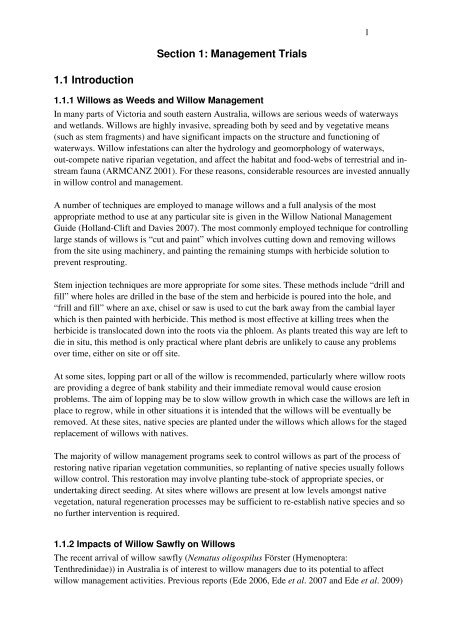Willow Sawfly Management Trials - Weeds Australia
Willow Sawfly Management Trials - Weeds Australia
Willow Sawfly Management Trials - Weeds Australia
Create successful ePaper yourself
Turn your PDF publications into a flip-book with our unique Google optimized e-Paper software.
1Section 1: <strong>Management</strong> <strong>Trials</strong>1.1 Introduction1.1.1 <strong>Willow</strong>s as <strong>Weeds</strong> and <strong>Willow</strong> <strong>Management</strong>In many parts of Victoria and south eastern <strong>Australia</strong>, willows are serious weeds of waterwaysand wetlands. <strong>Willow</strong>s are highly invasive, spreading both by seed and by vegetative means(such as stem fragments) and have significant impacts on the structure and functioning ofwaterways. <strong>Willow</strong> infestations can alter the hydrology and geomorphology of waterways,out-compete native riparian vegetation, and affect the habitat and food-webs of terrestrial and instreamfauna (ARMCANZ 2001). For these reasons, considerable resources are invested annuallyin willow control and management.A number of techniques are employed to manage willows and a full analysis of the mostappropriate method to use at any particular site is given in the <strong>Willow</strong> National <strong>Management</strong>Guide (Holland-Clift and Davies 2007). The most commonly employed technique for controllinglarge stands of willows is “cut and paint” which involves cutting down and removing willowsfrom the site using machinery, and painting the remaining stumps with herbicide solution toprevent resprouting.Stem injection techniques are more appropriate for some sites. These methods include “drill andfill” where holes are drilled in the base of the stem and herbicide is poured into the hole, and“frill and fill” where an axe, chisel or saw is used to cut the bark away from the cambial layerwhich is then painted with herbicide. This method is most effective at killing trees when theherbicide is translocated down into the roots via the phloem. As plants treated this way are left todie in situ, this method is only practical where plant debris are unlikely to cause any problemsover time, either on site or off site.At some sites, lopping part or all of the willow is recommended, particularly where willow rootsare providing a degree of bank stability and their immediate removal would cause erosionproblems. The aim of lopping may be to slow willow growth in which case the willows are left inplace to regrow, while in other situations it is intended that the willows will be eventually beremoved. At these sites, native species are planted under the willows which allows for the stagedreplacement of willows with natives.The majority of willow management programs seek to control willows as part of the process ofrestoring native riparian vegetation communities, so replanting of native species usually followswillow control. This restoration may involve planting tube-stock of appropriate species, orundertaking direct seeding. At sites where willows are present at low levels amongst nativevegetation, natural regeneration processes may be sufficient to re-establish native species and sono further intervention is required.1.1.2 Impacts of <strong>Willow</strong> <strong>Sawfly</strong> on <strong>Willow</strong>sThe recent arrival of willow sawfly (Nematus oligospilus Förster (Hymenoptera:Tenthredinidae)) in <strong>Australia</strong> is of interest to willow managers due to its potential to affectwillow management activities. Previous reports (Ede 2006, Ede et al. 2007 and Ede et al. 2009)
















